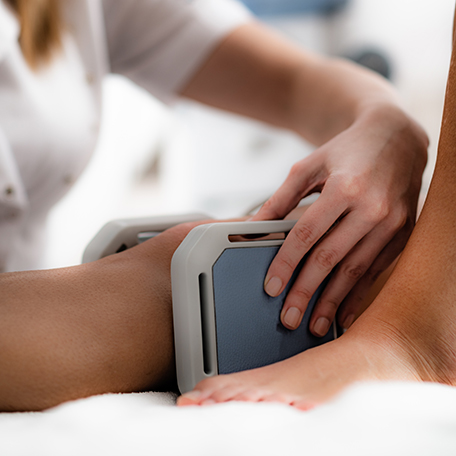Plaque is an insidious substance—a colorless, sticky film—that blankets your teeth and creates an environment in which bacteria erode tooth enamel, cause gum irritation, infection in inner structures such as pulp and the roots, and in extreme cases, tooth loss. Some of the biggest culprits causing
Read more

Overview
Have you tried different forms of therapy to treat your anxiety and depression but nothing's working? Or are you interested in finding a non-drug option to manage your chronic pain? An electromagnetic therapy session with us might be just what you need. Here's what you should know about the different types of electromagnetic therapy for functional medicine.
What is Electromagnetic Therapy?
Electromagnetic therapy is the practice of using electromagnetic fields to treat the symptoms of illness and disease. It is also referred to as magnetic field therapy or magnetic healing.
This form of functional medicine is based on the belief that our bodies contain magnetic and electrical fields. An imbalance or disruption to any of these fields results in illness. Different forms of electromagnetic therapy can be prescribed to restore balance and increase your overall physical and mental well-being.
What are the Different Forms of Electromagnetic Therapy
Electromagnetic therapy is a non-invasive form of functional medicine that can be used to treat everything from depression and Parkinson's to chronic pain and migraines. Several different types of electromagnetic therapy can be prescribed depending on your health concerns. These include:
- Transcranial Magnetic Stimulation (TMS)
- Transcutaneous electrical nerve stimulators, or TENS or musculoskeletal pain
- Pulsed electromagnetic field, or PEMF for acute or chronic pain
What Are the Benefits of Electromagnetic Therapy?
There are multiple benefits to undergoing electromagnetic therapy. Along with being a non-invasive practice, electromagnetic therapy does not involve the use of narcotics. In fact, pulsed electromagnetic field therapy (PEMF) is recommended as a replacement non-drug option to manage chronic and acute symptoms of pain. Electromagnetic therapy has also been shown to:
- Treat and manage symptoms of depression and anxiety
- Treat patients with Parkinson's
- Reduce pain, especially in patients with knee osteoarthritis
- Improve muscle mobility and flexibility
What to Expect During an Electromagnetic Therapy Session
A trained clinician at Chris Strickland will ask you a series of questions regarding your current health status to help determine which form of electromagnetic therapy is best suited for you. A normal TMS treatment plan to treat patients with depression will occur five to six times a week over the course of a 4-6 week period. During your session, you will be asked to sit in a treatment chair, and the clinician will use a treatment coil to send magnetic pulses to the part of your body that's showing symptoms of illness. Electromagnetic therapy sessions typically last 30 minutes, and recurring treatment is often recommended before seeing an improvement in your overall wellness.
For more information about electromagnetic therapy contact Chris Strickland at (706) 769-9779.
-
What is Tooth Decay?
Category: Tooth Care
-
Wisdom Teeth
Category: Dental Problems
Wisdom teeth are the third and final set of molars that erupt in the back corners of the upper and lower normal adult mouth. Unfortunately, most people experience problems from wisdom teeth; in most cases, this is because the teeth erupt too close to existing permanent teeth, causing crowding, improper
Read more -
Women and Tooth Care
Category: Tooth Care
Women have special needs when it comes to their oral health. That’s because the physical changes they undergo through life—menstruation, pregnancy and childbirth, breast-feeding and menopause—cause many changes in the body, some harmful to teeth and gums. Lesions and ulcers, dry sockets, as
Read more -
X-Rays
Category: Tooth Care
When X-rays pass through your mouth during a dental exam, more X-rays are absorbed by the denser parts (such as teeth and bone) than by soft tissues (such as cheeks and gums) before striking the film. This creates an image on the radiograph. Teeth appear lighter because fewer X-rays penetrate to reach
Read more -
Your Feet at Work
Category: Foot Anatomy
Whether you work in an office, a factory, or any other environment, your feet play a vital role in keeping you productive and comfortable throughout the workday. This article explores the importance of foot health in the workplace and provides tips for maintaining healthy feet while on the job. Understanding
Read more -
Your First Dental Visit
Category: Patient Information
Your first dental visit promises to be a pleasant experience. Making sound decisions about your dental care and oral health is an easy thing to do with the right preparation beforehand: Make a list of questions to ask our office, so you don't forget anything on the day of your appointment. This
Read more -
Your Footprint
Category: Foot Anatomy
Your footprint is more than just a mark left on the ground—it can provide valuable insights into the health and structure of your feet. In this article, we'll explore the different types of footprints, what they can reveal about your feet, and how you can use this information to maintain foot health. Types
Read more -
Your Rights and Responsibilities as a Patient
Category: Patient Information
Patient Rights You have a right to choose your own dentist and schedule an appointment in a timely manner. You have a right to know the education and training of your dentist and the dental care team. You have a right to arrange to see the dentist every time you receive dental treatment, subject to
Read more
Contact Us
Send Us An Email
Our Location
Find us on the map
Hours of Operation
Our Regular Schedule
Monday:
8:00 am-5:00 pm
Tuesday:
8:00 am-5:00 pm
Wednesday:
8:00 am-5:00 pm
Thursday:
8:00 am-5:00 pm
Friday:
Closed
Saturday:
Closed
Sunday:
Closed